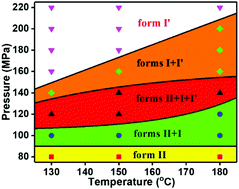Polymorph selection during melt crystallization of the isotactic polybutene-1 homopolymer depending on the melt state and crystallization pressure†
Abstract
This work investigated the crystalline forms obtained from melt crystallization in the isotactic polybutene-1 (iPB-1) homopolymer via manipulation of the temperature at which samples were melted (Tmelt) and crystallization pressure (Pcry). Unlike the results under atmospheric conditions where the molten sample crystallized into the pure form II and the crystallization temperature and kinetics were affected obviously by Tmelt, the melted sample crystallized into forms II or I′ under high pressure, depending on Tmelt and Pcry. The content of form I′ decreases with increasing Tmelt or decreasing Pcry. Meanwhile, the critical pressure for the formation of pure form I′ increases with increasing Tmelt. The formation of form I′ is attributed to the memory effect of the melt which preserved some ordered sequence of crystal and the high pressure (Pcry) which suppressed the nucleation and growth of the kinetically favored form II, which results in the formation of form I'. In addition, the melt crystallized form II transforms to form I under high pressure conditions; thus forms I, I′ and II are observed. The relative contents of the three crystalline forms on samples for different Tmelt and Pcry are obtained in this work. The result shows that the crystalline forms in melt crystallization of iPB-1 can be customized by regulating the melt state and crystallization conditions.



 Please wait while we load your content...
Please wait while we load your content...